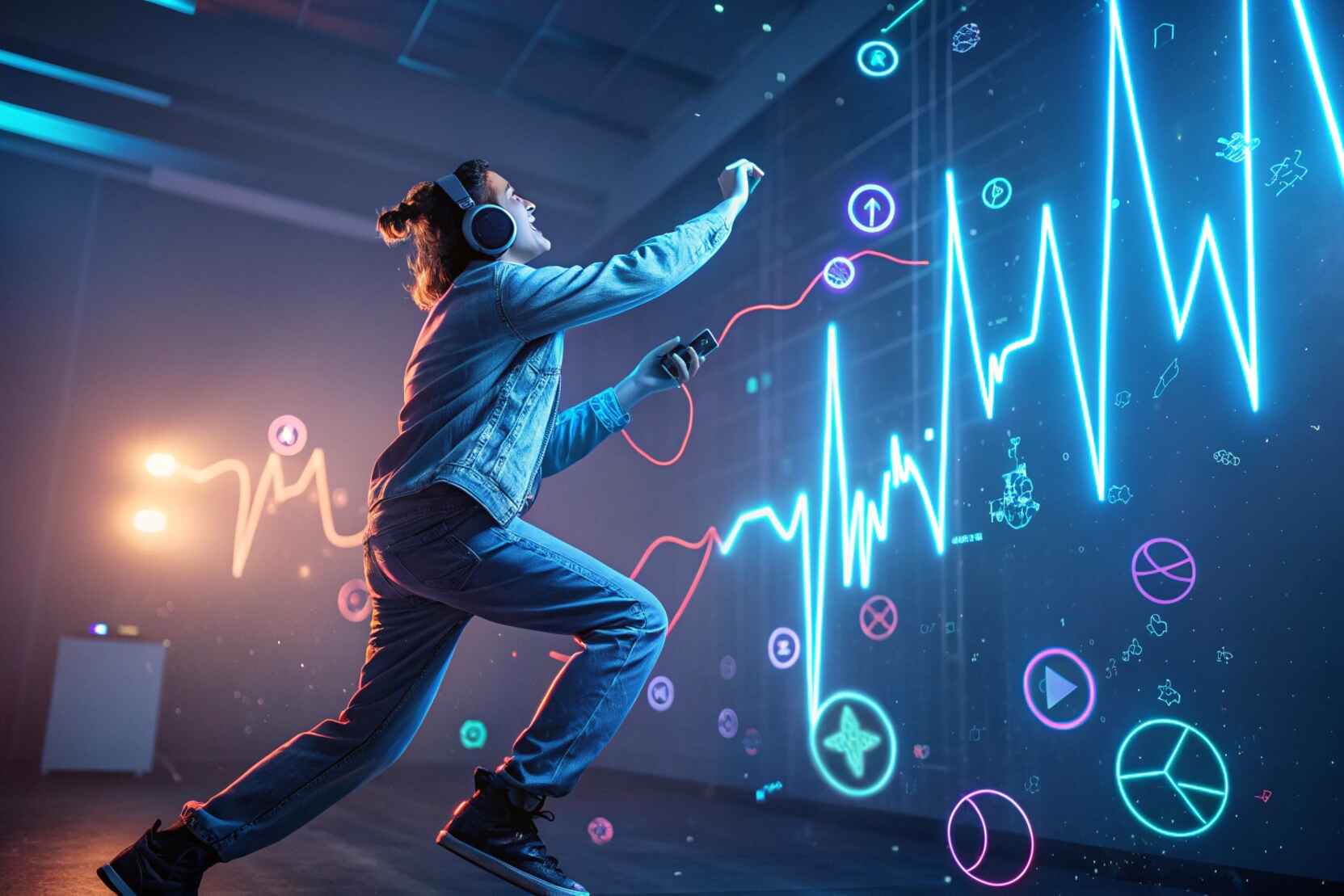In the evolving world of digital entertainment, Harmonicode’s video gaming by harmonicode introduces a refreshing take on interactive gameplay. This innovative genre blends rhythm, music, and real-time action to create experiences that are both immersive and responsive.
Unlike traditional games, where music is a backdrop, Harmonicode places it at the core of every movement. Players are not just participants—they become performers, syncing actions with beats in a dynamic, AI-driven environment. It’s a bold step toward redefining how games are played, felt, and enjoyed across platforms.
What Makes Harmonicode Gaming Stand Out?
Harmonicode games are developed around the concept of music-powered mechanics. That means everything in the game—from movements and attacks to level design and enemy actions—relates directly to the rhythm and beats of a soundtrack.
Each beat counts. Timing becomes everything. Miss the rhythm, and you miss your chance to attack or dodge. Stay in sync, and you progress with style and efficiency. This creates not just a challenge, but a flow state, where players feel completely absorbed in the game’s rhythm.
Why This Genre Matters More Than Ever?
Gaming is no longer just about high scores. It’s about connection, immersion, and expression. Harmonicode games capture all three. They turn gameplay into a multi-sensory experience that speaks to emotion, creativity, and timing.
In an age where entertainment must feel personal and meaningful, hmcdgamers video gaming by harmonicode stands out as a shining example of how games can evolve without losing their fun.
Key Features of Hmcdgamers Video Gaming by Harmonicode:
Let’s break down the signature features of this genre:
| Feature | Description |
| Rhythm-Based Actions | All actions are triggered in time with a musical beat |
| AI-Driven Sound Adaptation | Soundtracks change in real-time based on player performance |
| Dynamic Environments | Worlds shift and evolve according to the game’s soundtrack |
| Skill-Based Gameplay | Success is driven by timing, reflexes, and listening skills |
| Cross-Platform Access | Available on mobile, PC, VR, and AR platforms |
| Multiplayer Modes | Cooperative and competitive rhythm challenges |
| Personalized Difficulty | AI adjusts challenges to match player rhythm and skill level |
These elements work together to create a deeply personal and immersive experience for players of all levels.
How Does Harmonicode Achieve Smooth Sync Between Gameplay and Music?
One of the most exciting aspects of hmcdgamers by harmonicode is how well the gameplay syncs with the music. Rather than having music as an add-on, it becomes the actual guide for interaction. Imagine a platforming game where each jump is timed with a drum beat, or a battle game where each strike lands on a snare.
This musical alignment adds a new layer of mental engagement, pushing players to listen carefully and react accordingly. It transforms routine gameplay into an active listening experience, where timing becomes as important as strategy. Players don’t just respond to visuals—they anticipate movements through rhythm. Over time, this trains reflexes, sharpens focus, and deepens the emotional connection between the player and the game world.
The Role of Artificial Intelligence in Harmonicode Games:
Harmonicode doesn’t rely on preset tracks and static gameplay. AI is at the heart of its innovation.
AI Enhancements Include:
- Adaptive Soundtracks: The music gets more intense or calming based on your actions.
- Real-Time Adjustments: Difficulty changes depending on your performance.
- Environmental Reactions: The AI shifts lighting, enemy speed, or obstacles to match the rhythm.
This use of AI helps make every playthrough feel unique and personalized.
Game Titles Driving the hmcdgamers Community:
Several standout games are already shaping this new genre. These titles vary in theme but follow the same principle of rhythm-based interaction.
Popular Harmonicode Titles:
| Game Title | Gameplay Style | Key Feature |
| BeatStorm | Rhythm-shooter hybrid | Shoot enemies to the beat of an energetic track |
| Rhythm Quest | Adventure game with beat puzzles | Solve puzzles and complete missions in time |
| SoundRush Arena | Multiplayer competitive battles | Rhythm-based combat and dodging challenges |
| Flow Sync | VR exploration and rhythm movement | Navigate worlds by syncing with soundwaves |
These games help define the community known as “hmcdgamers,” a group of players passionate about rhythm-integrated storytelling and interaction.
How does This Genre Engages Different Types of Players?
For Casual Gamers:
The rhythm-based design of hmcdgamers by harmonicode offers a low-barrier entry point for casual players. You don’t need expert skills or deep gaming knowledge—just a basic sense of timing. The intuitive gameplay makes it easy to jump in, enjoy the beats, and feel accomplished without the pressure of complex mechanics or steep learning curves.
For Hardcore Gamers:
Hardcore gamers will find depth and challenge in every session. The fast transitions, layered musical patterns, and adaptive AI push them to react with precision and master rhythmic timing. Achieving perfect sequences becomes a rewarding pursuit. These games demand focus, skill, and consistency—offering a satisfying and competitive edge for those seeking high-level performance.
For Music Lovers:
For those passionate about music, these games deliver more than entertainment—they offer a meaningful experience. Every action ties into a song’s rhythm, transforming gameplay into a musical journey. Players feel connected to the soundtrack, as their moves influence the flow. It’s a beautiful blend of listening, expression, and interaction through sound-driven design.
How Is Technology Powering the Future of Music-Driven Games by Harmonicode?
To deliver such a rich and responsive experience, hmcdgamers video gaming by harmonicode relies on a seamless blend of advanced technologies. These aren’t just tools—they’re the foundation that powers gameplay, interaction, and real-time adaptability. Behind every perfectly timed jump or rhythm-synced attack is a stack of sophisticated tech working in harmony.
Harmonicode uses a powerful mix of development engines, AI systems, cloud infrastructure, and immersive tech to bring music-driven gameplay to life. This synergy between software and innovation ensures the experience feels fluid, precise, and always engaging.
Key Technologies Include:
- Unity & Unreal Engine: These industry-leading engines allow for smooth motion, cinematic visuals, and immersive 3D worlds. Unity provides flexibility for mobile and casual experiences, while Unreal delivers high-fidelity graphics and real-time physics—perfect for rhythm-based action scenes and transitions that pulse with the soundtrack.
- Custom AI Models: Harmonicode’s proprietary AI doesn’t just adjust difficulty—it listens and responds. These models evaluate player performance and react in real time, modifying level elements, enemy behavior, and tempo to match your rhythm. This creates a personalized challenge that evolves continuously with each session.
- Cloud Architecture: Multiplayer gameplay requires stability and scalability. Harmonicode’s cloud systems handle matchmaking, real-time syncing between players, and dynamic updates—ensuring smooth interactions, minimal lag, and data storage that can grow with the community.
- VR and AR Platforms: Virtual and augmented reality are transforming how players engage with games. Harmonicode integrates motion tracking and spatial awareness to create physical rhythm-based experiences. Whether ducking to a beat in VR or stepping to a tempo in AR, players move, react, and immerse more deeply.
- Spatial Audio and 3D Sound Engines: To make music feel real, spatial audio plays a critical role. Sounds shift based on player movement and environment, giving every rhythm a direction and depth. This adds realism and intensity, pulling players deeper into the soundscape.
How Is Harmonicode Creating a Social and Cultural Shift in Gaming?
What makes Harmonicode more than just a game studio is its mission to create a connection through rhythm. Communities form around these games not only to compete but to share experiences, music, and strategies. Custom pins, music remixes, fan-made levels, and collaborative events have created a sense of identity among the players.
For some, it’s not just a hobby—it’s part of their lifestyle. Players proudly express their in-game achievements in real life, wearing game-themed gear and sharing highlights across social media. This sense of belonging strengthens the bond between players and transforms gaming into a shared culture.
Can Gaming Feel Like a Live Performance with HmcdGamers?
These games can feel more like performance art than traditional gameplay. Players are not just pressing buttons—they’re interacting with rhythmic patterns that demand precision, timing, and a touch of creativity. Every action becomes part of a larger musical flow, turning gameplay into a form of expressive performance.
This performance-based model appeals strongly to dancers, musicians, performers, and even casual players who enjoy engaging with sound in a more meaningful way. It’s not just about winning—it’s about syncing with the rhythm, expressing yourself through movement, and becoming part of the music. Whether you’re gliding through a beat-driven landscape or battling enemies in sync with a tempo, hmcdgamers by Harmonicode turns every session into a stage—and every player into a performer.
The Future of Harmonicode Games:
As the gaming industry leans more into immersive experiences, hmcdgamers by harmonicode is already laying the foundation for what’s next.
Future Innovations Expected:
- User-Generated Music Levels: Players can upload tracks and create levels around them.
- Biometric Integration: Games adapt to your heartbeat or physical movements.
- AR-based Concert Mode: Watch or perform musical gameplay in augmented reality.
The growth of 5G, cloud gaming, and wearable tech will only help push these boundaries further.
FAQs:
1. What Was the First Video Game Ever Created?
The first known video game was “Tennis for Two”, made in 1958 by William Higinbotham. It simulated a tennis match. Later, “Pong” (1972) became the first commercially successful arcade game, helping launch the video game industry.
2. When Was the First Computer Game Invented and What Was It Called?
The first computer game was “Spacewar!”, created in 1962 by MIT students. It featured two spaceships fighting in space. It wasn’t for sale, but it spread to universities and inspired many future video games and early developers.
3. What Was the First Video Game Console?
The Magnavox Odyssey, released in 1972, was the first home video game console. It connected to a TV and offered basic black-and-white games like table tennis. It paved the way for all future gaming systems and home entertainment.
4. What Was the Second Video Game After Pong?
Atari’s “Space Race”, released in 1973, followed the success of Pong. In this game, players raced spaceships upward while avoiding obstacles. It was one of the first racing games and helped expand the types of gameplay available.
5. How Did Video Games Develop in the 1980s?
The 1980s saw huge growth in gaming with arcades, home consoles like the NES, and classics like Pac-Man and Super Mario Bros. This era shaped the gaming industry, making video games a popular form of global entertainment.
Conclusion:
hmcdgamers video gaming by harmonicode represents a bold evolution in how players experience games—blending rhythm, music, and adaptive gameplay into something uniquely immersive. It’s not just a genre but a movement, where performance and play meet in harmony.
As technology continues to grow and players seek deeper, more meaningful engagement, Harmonicode is shaping the future of interactive entertainment. This rhythm-driven approach not only redefines gameplay mechanics but also builds a cultural community where every beat connects players around the world.
Related post:









